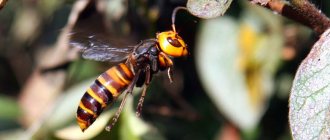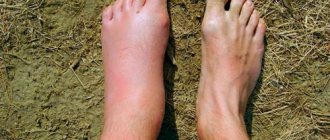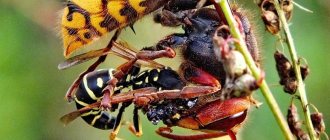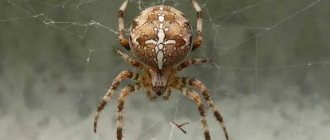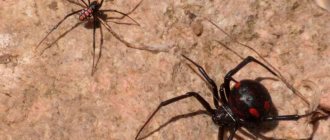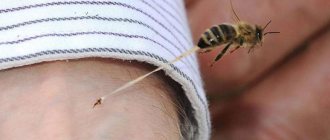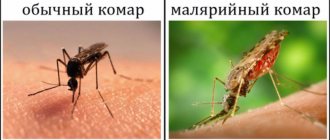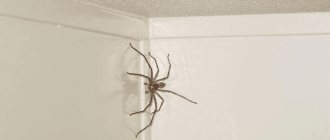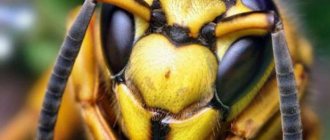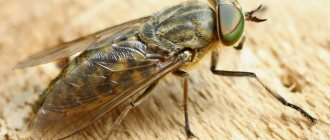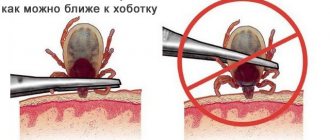A menacing buzzing makes many people anxious, and if something similar to a hornets’ nest appears in sight, there is a desire to get as far away from the dangerous place as possible. This is how people react to a potential threat. And this is correct, because the maximum risk of a bite occurs within a radius of 2–3 m from the nest.
Who is a hornet and why is it dangerous to humans? What to do if it bites and what could be the consequences? How to get rid of them and how do they differ from bees, wasps and bumblebees? Let's figure it out.
Who is the hornet
This is the largest representative of the so-called paper or social wasps. Their Latin name is Vespa, which literally translates as “wasp”. However, these are different insects that belong to the same family - true wasps.
Initially, no difference was made between the two representatives, and only in the 19th century the Vespa genus was divided into two groups. The description was based on several characteristics, but the main one was size - hornets are larger and can reach a length of up to 5.5 cm. Insects that are today considered wasps are designated in Latin as Vespula, that is, “small wasp.” Their size is 1.5–2 cm in length.
The hornet's threatening appearance is given by the bright coloring of its head - a combination of yellow, black, and orange.
The aggressive image is complemented by a striped belly, strong jaws and large eyes. However, these insects, unlike wasps, are non-aggressive. Human bites occur when a nest is disturbed or in self-defense.
Biological description
Hornets belong to the genus - social wasps. They live in families. A swarm can include up to several thousand individuals. Their life processes are clearly organized. Thus, within the “community” there are separate “castes” that perform specific functions.
The task of the hornet queen is to leave offspring. She is the leader of the colony. Females are born from fertilized eggs in August and September. Hornets reproduce by mating mature insects. After the females are fertilized, the males die.
The female stores sperm during the winter. With the onset of warm spring days, the queen begins to actively feed and regain strength in order to begin creating honeycombs for laying eggs. Thus, it forms the foundation of the future nest.
How long a hornet lives depends on its “profession”. Thus, males exist for one season, and the lifespan of the queen is a year.
The insect also has powerful jaws - mandibles. Literally speaking, hornets not only sting by injecting poison, but also bite. The insect uses mandibles to tear and grind prey.
During the active season, hornets feed on the juice of overripe fruits, trees, and honey. They hunt caterpillars, dragonflies, flies, spiders, related bees and wasps. They also cope with larger insects - crickets, locusts. There are descriptions of species capable of attacking birds and frogs. The prey is not used for food—the mass chewed and treated with saliva is used to feed the larvae.
Nests
The structure of a hornet's nest is based on hexagonal honeycombs.
The material is a substance similar to paper or cardboard. This is a lightweight structural element with thermal insulation properties of a brown color, which is obtained by mixing tree bark with insect saliva.
The place for the nest is chosen by the queen hornet. She does it where the offspring will be protected from excessive heat, cold and prying eyes.
Hornet nests reach 50–70 cm in length and are located in tree hollows, abandoned or used premises, cavities under roots, and piles of dead wood.
In the European Union, hornets are protected by law. For example, in Germany, the destruction of their nests is punishable by a large fine.
Area
Most species of hornets live in areas with a temperate climate, mainly in the northern hemisphere. Entomologists believe that they originally lived primarily in East Asia. There are several types of hornets on the territory of Eurasia, mainly the common and oriental ones.
People themselves play a major role in the spread of the insect. For example, a representative of the “common” species came to North America along with colonists from Europe in the middle of the 19th century.
In Russia, the hornet lives on a vast territory, which includes the European part of the Urals, Transbaikalia, the Amur region, and southern Sakhalin.
Kinds
Representatives of the extensive Vespa genus include more than 20 species.
- Affinis - small striped one.
- Analis - found in East Asia, measuring 25–28 mm.
- Basalis - basal.
- Bellicosa - warlike.
- Bicolor - two-color.
- Binghami - Binghama - active at night.
- Crabro - ordinary.
- Ducalis - commander's - one of the largest in Russia.
- Velutina is tropical, but also lives in Europe, as it was accidentally introduced there.
- Dybowskii - Dybovsky - almost monochromatic - black-brown.
- Fervida - ardent.
- Fumida - variable.
- Mandarinia is the largest in the world and also very poisonous.
- Multimaculata - multi-spotted.
- Orientalis - eastern.
- Philippinensis - Philippine.
- Luctuosa is tropical, found in the Philippines and is the most poisonous.
- Simillima - similar, very similar to the common hornet.
- Vivax - lives in Asia.
- Soror - black-tailed.
- Tropica - tropical.
Eight species of hornets live in Russia. The leader in occurrence is the “ordinary” (Vespa Crabro), which is distributed throughout almost the entire country, including the Moscow region. It is absent only in northern latitudes. The eastern hornet (Vespa Orientalis) lives in the Caucasus. In the south of the Far East, six species of Vespa are found - Simillima, Dybowskii, Ducalis, Mandarinia, Analis, Dinghami.
Role in nature
The benefits that hornets bring:
- destroy harmful insects that parasitize garden crops and wild plants - aphids, mites, psyllids;
- pollinate plants;
- They hunt locusts, flies, wasps, sick, “old” bees.
Natural enemies of hornets in nature limit their population within useful limits and destroy sick individuals. Among animals, these are ants, some species of birds (starlings, wagtails). Hornets are also susceptible to parasites - mites, nematodes, parasites and even microscopic fungi.
Interesting Facts
There are more than 20 species of hornets in the world, differing in color, behavioral characteristics, and size. The largest representative is the Asian one (Vespa Mandarinia), whose length exceeds 5 cm. In China, it is known as the “bee tiger”. Its venom contains a neurotoxin.
The hornet's queen releases pheromones that influence males. With their help, the “queen” organizes the activities of the entire swarm.
In the 18th century, the French naturalist, physicist and mathematician René Antoine Reaumur studied the material from which wasps build their nests. The result was a proposal to use wood in the production of paper, because until that moment, it was made from rags.
Life cycle
An entire generation of giant wasp comes from one queen.
Spring
In the spring, she is looking for a place to start building for the new generation. The Queen produces the first honeycomb herself. Later the queen lays eggs in them. After a few days, larvae appear, which need animal food. The female catches caterpillars, beetles, butterflies, and other insects to feed her offspring. The grown larva secretes and becomes a pupa. After 14 days, the young individual gnaws the cocoon.
Summer
In mid-summer, working females and males grow up. They complete the honeycombs and bring squirrels to the larvae. The queen no longer leaves the home and lays eggs.
Life expectancy is short. Insects grow by the end of summer, but in September a significant part die. Surviving individuals can survive until the first cold weather.
Autumn
The population peaks in September. The queen lays eggs during her last clutch. From them females emerge, which subsequently become new queens.
Previous individuals are obtained with modified ovaries. Their functions are suppressed by the queen's pheromones. The young swarm near the hive and mate. Sperm collected in the fall is stored to create a new generation. After mating ends, the male can live up to 7 days. The old queen is kicked out.
Why is a hornet dangerous for humans?
The following components of the poison pose a danger to humans:
- phospholipase A2 is an enzyme that activates the inflammatory response;
- acetylcholine is a neurotransmitter that ensures the transmission of impulses;
- histamine is a mediator of immediate allergic reactions;
- mastoparan is a toxin of protein origin.
As a result of the influence of a “bouquet” of biologically active substances on the tissues of the human body, a protective systemic inflammatory response develops.
A hornet sting can be fatal to humans if the victim experiences an allergic reaction. The following complications may also develop:
- skin rashes;
- bronchospasm - obstruction of the airways with difficulty exhaling;
- hallucinations;
- paroxysmal pain in various parts of the abdomen, nausea, vomiting;
- convulsive syndrome;
- depression of consciousness;
- a sharp decrease in blood pressure with further cessation of blood circulation.
Single hornet bites during pregnancy and lactation do not pose a danger to the fetus and infant, since the amount of poison is insignificant to penetrate the placental barrier or into the liver of a nursing mother.
How dangerous is a hornet bite for a child? Due to the small body weight, the concentration of poison for his body is very high, so the symptoms are more pronounced. And also due to the fact that children react actively and unpredictably to buzzing insects, the risk of multiple attacks increases, increasing the development of allergic reactions. In order not to risk the child’s life if bitten, you should immediately call an ambulance, without waiting for allergies to appear and anaphylactic shock to develop.
Relieving pain and swelling - folk remedies
What to do at home in case of a hornet or wasp bite? If the symptoms are not severe and there are no complications, you can carry out treatment with traditional methods without resorting to professional help. The most popular are various lotions and ointments made from the pulp of vegetables, crushed herbs and the juice of some plants.
However, when using folk remedies, it is better to first find out whether there is an allergy to any of the components. Otherwise, you can only worsen the consequences of the bite, and treatment will take a long time.
Lotions for swelling
If you have been bitten by a wasp and the area around the wound is swollen, you can try using herbal infusions as lotions. Regular parsley is a reliable anti-inflammatory agent; for the lotion you will need to squeeze out the juice of the plant.
How to do it:
- rinse the parsley;
- finely chop and mash with a spoon to a paste;
- wrap in cheesecloth and squeeze out the juice.
The result should be a greenish liquid. You need to moisten a cotton pad or a piece of bandage in it and apply it to the wound. The fabric soaked in the solution must be fixed with a plaster and left in this form for several hours.
The lotion can be changed after 3-4 hours. Important! It is not advisable to mash parsley in wooden containers, since the material quickly absorbs the juice.
You can also remove the tumor with the help of calendula; for this you need to make a compress with an alcohol tincture of this plant. There is no need to dilute the product with water or herbal decoctions! The first lotion should lie on the wound for half an hour, then prepare a new mixture from:
- 30 g soda;
- 50 ml water;
- a small amount of calendula tincture.
All components must be mixed to a paste and rubbed into the bite site. Itching can also be relieved with the help of mint; to do this, simply mash the leaves with your hands or a spoon, apply to the wound and secure with a bandage or plaster. The bandage needs to be changed every 2-3 hours.
Sour fruits
If you don’t have anything in your home medicine cabinet to anoint the bite site with, you can use sour fruits. An acidic environment can neutralize the poison, so if you are bitten by a wasp, you can treat it with lemon juice. To do this, just cut the fruit into slices and apply to the affected area.
If necessary, you can make a lotion by first squeezing lemon juice and moistening gauze with it.
If you don’t have lemon on hand, you’ll almost certainly have table or apple cider vinegar in your kitchen cabinet. Important! Vinegar in lotions is used only in diluted form!
An excellent substitute for lemon juice would be sour apples. They can be used in different ways:
- apply halves of the fruit to the wound and gently massage the skin with them so that the juice is better absorbed;
- Make apple pulp and apply it to the affected area of the skin; this lotion needs to be renewed periodically.
Like lemon, apples help relieve itching and speed up the healing process. With this treatment, the swelling will disappear in two to three days.
Garlic paste
Swelling and redness can be removed with garlic. This plant has bactericidal properties and helps relieve inflammation. To make a medicinal paste, several cloves need to be peeled and crushed or finely chopped.
The paste should be applied to the bite site and the skin around it, then covered with gauze and left for 2 hours.
During the process, you may feel a burning and tingling sensation, but this will go away after a while. Instead of garlic, you can use onions. Since both plants have very caustic juice, you should not apply the pulp into the wound itself.
Tomatoes and potatoes
What to do if a wasp stings your leg or arm? If there are no pronounced side effects, you can use tomato pulp. In this case, you can use both ripe and green fruits. In this case, there is no need to grind green tomatoes into a paste; just apply half of them to the bite site and secure with a bandage.
Potatoes, finely grated to a paste, will also help get rid of swelling and redness. The mass should be placed in a bag of gauze or thin cotton fabric and applied to the sore spot. You need to keep the bag for 1 hour.
When is a visit to the doctor necessary?
Hospitalization of the victim is necessary if:
- The victim has anaphylactic shock;
- The insect stung you in the face or neck;
- After a bite, breathing is difficult;
- Too much swelling;
- Weakness;
- A child was injured;
- Pallor;
- Heart rhythm disturbance.
In all of the above cases, you cannot self-medicate; you must immediately consult a doctor.
Causes of a hornet sting
The main reason for a hornet bite is self-defense, and it always tries to get away from a person first and stings only if it is grabbed.
The insect uses its sting only for the purpose of protection or to neutralize a resisting victim. Entomologists explain that hornets will not consume poison without justified biological expediency. After all, this is a valuable weapon that is necessary during hunting.
Having detected a threat, hornets release alarm pheromones, which call on other individuals to attack. Therefore, everyone who is within a radius of 2–3 meters from a disturbed nest or a killed hornet will be bitten.
Creating a Nest
Hornet's nest.
To create a nest, hornets choose a secluded place that is protected from drafts. Insects are excellent architects. They are able to create unique homes.
Birch or ash wood is used in construction. It is moistened with saliva. The surface of the nest is similar to cardboard or corrugated paper. The structure expands downward. There are about 500 cells in a honeycomb. The color of the cocoon is influenced by the wood. Most often it has a brown color.
Bite symptoms
The hornet does not leave a sting when it bites, so it can sting several times. This feature distinguishes it from bees. A large number of bites can be fatal to humans. Especially if you are allergic to wasp venom.
Symptoms that develop from a hornet bite:
- sharp, severe pain;
- swelling, redness;
- itching, burning at the bite site;
- increase in body temperature to high numbers;
- possibly manifestations of allergic reactions, including anaphylactic shock.
First aid
What to do if bitten by a hornet? It all depends on where and under what circumstances it happened. It is important to protect people from mass attacks. The biological instincts of insects are aimed at survival, which means protection from external invasions. If there is a nest within 2–3 m, you must immediately leave the danger area. When indoors, you should close the windows and make sure there are no insects.
If a hornet bite occurs, the algorithm for providing first aid at home should be as follows:
- examine the wound;
- if a sting remains, for example, after hitting an insect, then carefully remove it;
- do not try to squeeze out the poison;
- suck out the contents of the wound as quickly as possible;
- treat the bite site with an alcohol wipe or liquid;
- to relieve pain and swelling, apply “cold”;
- if there are indications, then take an antiallergic drug, for example, Suprastin or Tavegil.
When treating a hornet sting at home, it is important to continue to monitor the condition of the victim. If alarming symptoms appear, you should consult a doctor.
What to do if a hornet bites a child? The algorithm of actions for providing first aid is the same as for adults. Then you need to calm the baby down, distract him from the unpleasant incident and seek the advice of a medical specialist. Incorrect assessment of symptoms, potential complications, and self-medication can significantly worsen the child’s condition.
Medicines
After a hornet bite, it is imperative to take an antihistamine as soon as possible. New generation antiallergic drugs that work for a long time and do not cause drowsiness include:
- Suprastinex;
- Fexofenadine;
- Cetrin;
- Erius.
- First aid for a hornet bite involves treating the bite site with hydrogen peroxide or diluted ammonia. In cases where there are no medications at hand, clean water is used for rinsing. After wiping, wet sugar is applied to the wound - this is another method that allows you to draw out the poison. Place a damp cold towel on top of the sugar. This application will work for 10 minutes - after this time the sugar must be removed and a compress with citric acid or acetic acid applied instead. An acidic environment will be an antidote to the alkaline hornet venom. As a last resort, you can apply a piece of lemon or apple to the wound.
To slow down the spread of the toxin throughout the body, apply a heating pad with ice water to the affected area. This manipulation will also slightly reduce swelling. In addition to drugs for internal use, treatment includes ointments for topical use:- Fenistil-gel;
Rescue balm;
- Fluorocort;
- Psilo-balm.
Sorbents are also indicated for oral administration, which will reduce the level of toxin in the blood, and, consequently, the manifestations of intoxication. For this you can use Polysorb, Enterosgel, Smecta, activated carbon.
Treatment
In the International Classification of Diseases, Tenth Revision ICD-10, a hornet sting is designated by code W57 - stinging by non-venomous insects and arthropods.
There is no specific antidote for a hornet sting. Therefore, treatment includes the use of the following drugs:
- analgesic;
- antihistamine;
- antipyretic;
- decongestant.
If life-threatening complications develop, intensive therapy is carried out in the intensive care unit.
If a hornet bites you on the head, namely, in the area of the face or neck, swelling may develop that affects the airways. This condition threatens the life of the victim and requires treatment in a hospital. Airway obstruction is an indication for hospitalization in the intensive care unit. Intensive therapy includes the administration of glucocorticosteroids (hormones of the adrenal cortex), diuretics, and, if necessary, connection to a ventilator.
Consequences
- children;
- elderly and senile people;
- patients with a history of allergies, chronic diseases of the heart, blood vessels, and respiratory organs.
The severity of symptoms and the possibility of developing complications depends on the health status of the victim.
If there was no allergic reaction of the body, then the inflammation caused by the hornet sting goes away in a few days. This can be judged by the reduction in swelling, redness, and pain in the wound area.
The damaged area may itch for some time. How to relieve itching after a hornet bite? It is enough to apply cold. If this is one of the symptoms of an allergic reaction, then you should consult a doctor who will prescribe antihistamines.
Some tips
Naturally, avoiding encounters with stinging insects, especially in summer, is not an easy task. They are everywhere: in the garden, in the vegetable garden, at the dacha, near the river, near the pond, in the forest, etc. Although rare, hornets do bite, especially children who like to explore green spaces in various places.
To protect yourself from attacks by such insects, it is enough to use a number of recommendations:
- When choosing a place to relax near a river or near green spaces, it is important to examine this place to identify a wasp nest or a hornet nest.
- Do not make sudden movements or wave your arms near places where stinging insects are active. Calm behavior will never become a reason for an attack by wasps, bees or hornets.
- You should not try to destroy a hornet nest by waving a stick or other object. The result is several hornet bites and at least a week in a hospital bed with severe symptoms, and possibly death.
On a note! As a result of hornet stings, serious consequences are possible and everyone should know about this. Untimely and unqualified assistance aggravates the consequences, especially for people prone to allergies.
To protect yourself from such consequences, it is better to be attentive and careful. Rash actions can lead to serious negative consequences. Moreover, innocent people may suffer.
How to get rid of hornets
Smells that repel them:
- soapy;
- essential oils contained in red hot pepper;
- aroma of mint, geranium, basil, wormwood;
- smoke.
If a hornet has flown into a room, it will explore the space in search of a way out until it finds one. Therefore, to get rid of it in a house or apartment, the best solution is to simply open the window wider and allow it to get out. If you try to catch it using a jar or vacuum cleaner, there is a chance of being bitten.
Remedies for hornets:
- insecticides - Get, "Medilis-Super", "Delta-Zone", aerosol from wasp nests Mosquitall;
- traps - Argus Garden, Swissinno Wasp Trap;
- smoke bombs - “Mukhoyar”, “Quiet Evening”, “FAS”, “City”;
- ultrasonic or acoustic insect repeller - EcoSniper LS-989, Sititek Flash, Grad Ultra 3D, Weitech WK-0180;
- insecticidal lamps - Well, Mo-El, Hilton.
What else are hornets afraid of? They are repelled by plants - basil, geranium, mint, lemon balm, wormwood, hanging red pepper pods. With their help, you can get rid of hornets in your garden, yard or attic of a private house. It is enough to plant or lay out dry plants near the nest and after a while the insects themselves will prefer to move to another place.
Difference from bee, wasp, bumblebee
| Wasp | Bee | Bumblebee | Hornet | |
| Size(cm) | 2,0–3,5 | 2,1–3,9 | 1,3–2,8 | Up to 5.5 |
| The structure of the sting | smooth | has jagged edges | smooth | smooth |
| Painful bite | The pain from a hornet sting is comparable in intensity to the sting of a wasp, bee or bumblebee. | |||
The hornet can also be confused with other insects.
- The gadfly is distinguished by its smaller size and color, which is dominated by gray and black shades. It belongs to synanthropic flies. Only one species attacks humans: the human skin botfly, which lives in Central America.
- The difference between Scolia and Hornet is in size. Its length is about 3 cm in females and 4.5 cm in males. There is also a difference in color - Scolia is almost all black, with only two yellow spots.
- A drone is a male honey bee. The difference from the hornet is in size (no more than 1.5–1.8 cm), less bright color and lack of a sting.
Let's summarize. The hornet is a large, brightly colored insect from the genus of social wasps. It has jaws and a sting hidden at the tip of the abdomen. People are bitten most often due to the instinct of self-preservation. This is facilitated by the fact that nests are often created in close proximity to human habitation. The consequences of a hornet sting are dangerous due to the appearance of an allergic reaction, with possible death from anaphylactic shock. Especially if the insect stung several times or a child, an elderly or senile person was injured. In this case, you should definitely seek professional medical help. If there was no allergy, then the inflammation goes away within a few days.
Tip size
Since the sting is the remains of a modified ovipositor, it is present only in female hunters. Males do not have such weapons and are absolutely harmless to large species of animals, but this does not make them any less dangerous to bees and those whom they consider future prey.
Ancient treatises that describe terrestrial animals claim fantastic facts - hornets can have a pair of stings, and their size ranges from small to large (several centimeters).
In reality, the sting is not so small in size - the most dangerous giant Asian hornet has a weapon of 1 centimeter. Common hornets, which are common in Russia, the USA, and Canada, their size is within four to six millimeters. In the photo you can carefully see what it looks like.
If you examine the sting under a microscope, you will notice 2 halves that are adjacent to one another. High magnification makes it possible to see that in bees it has the shape of a saw - there are jagged marks on the surface, but in hornets it is a dense tube created by durable chitin, the surface itself is hollow and smooth, the end is slightly pointed - this makes it possible to easily penetrate the skin victims.
When struck by an insect's sting, the muscle fibers located on the belly contract, resulting in a certain dose of poison entering the cavity of the “weapon.” All of us know what pain a syringe injection brings and what it feels like when medicine gets into the skin - the principle is the same when attacked by insects. But the pain experienced when bitten is not so much from the puncture of the skin, but from the influence of the poison.
